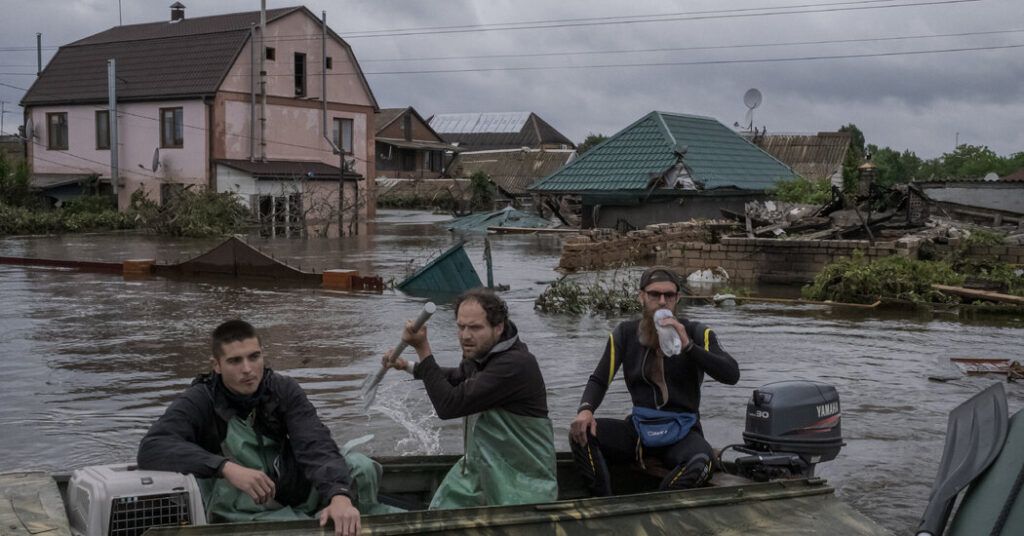Nearly two weeks after the destruction of the Kakhovka dam in southeastern Ukraine the floodwaters are receding, but local officials are grappling with a new concern: the potential for outbreaks of waterborne diseases.
On Saturday, local officials in Kherson and Mykolaiv, the two regions most affected by the flooding on the Dnipro River unleashed when the dam collapsed, outlined plans to ensure safe drinking water. And doctors in hospitals across those regions have been warned to prepare for possible outbreaks of infectious diseases.
“Currently, trucks carrying essential medical supplies for infectious diseases such as cholera are being unloaded,” Oleksandr Chebotarov, the medical director at the Kherson City Clinical Hospital, said in a phone interview on Saturday. “As of today, we have not had any reported cases of illness, but we are actively preparing.”
The full scale of the disaster, which drained a giant reservoir used for drinking water and irrigation, is only beginning to come into focus. Hundreds of residential areas are still inundated, including some under Russian occupation. International humanitarian organizations have shared concerns about widespread pollution and the chances of illness, but the Ukrainian health authorities maintain that they are vigilantly monitoring for signs of disease.
The potential for widespread disease comes as Ukraine’s forces are fighting in the early stages of a counteroffensive, trying to wrest back control of Russian-occupied areas. Hanna Maliar, a Ukrainian deputy minister of defense, said late Friday in a statement on the Telegram messaging app that Kyiv’s forces were “gradually moving forward” in the country’s south, and that in the east they were up against concerted Russian efforts to “to stop the offensive actions of the Ukrainian troops.”
On Saturday, a Russian anti-tank missile hit a civilian car in the Kharkiv region of northeastern Ukraine, killing two people, the head of the regional military administration, Oleh Syniehubov, said in a Telegram statement.
He posted images of smoke rising from the wreckage of a mangled car and said that the “direct hit” on the vehicle had killed a 42-year-old man and a 53-year-old woman.
But as the Ukrainian military campaign ramps up, civilians in areas near the front line now face not just the threat of fighting but also the specter of illness. Floods can increase the transmission of communicable, waterborne diseases like typhoid, cholera, leptospirosis and hepatitis A.
Jarno Habicht, the head of the World Health Organization’s country office in Ukraine, said in a statement to reporters this week that the organization had provided cholera kits to people in the Kherson region and neighboring areas “as a preventive measure” in the spring, before the dam was destroyed.
But Dr. Habicht cautioned that the situation was still evolving, and that hundreds of thousands of people were in danger of running out of safe drinking water in the coming weeks. The W.H.O. and partners in the field were also monitoring the long-term effects of the release of hazardous chemicals into the water supply, he added.
Ukraine’s Ministry of Health encouraged people in flood-affected areas to drink only bottled water, and said that water monitoring had been stepped up in those areas.
The ministry has tamped down fears about a cholera outbreak, saying that there had not been any registered cases or suspicions of cholera infections in Ukraine as of Wednesday. Samples from both environmental sources affected by the flooding and from patients with signs of acute intestinal infection had been studied and found to be negative, it said in a statement.
Viktor Lyashko, Ukraine’s health minister, said that the area downstream from the Kakhovka dam was heavily polluted and unsuitable for any use, including swimming or fishing. People and animals should not drink the water, he said in an interview with the BBC, adding that even bathing in the water could lead to illness.
“The treatment facilities have switched to emergency disinfection modes,” he said in the interview. “Monitoring of the water quality in the water supply network has been intensified to prevent an outbreak.”
In both Russian-occupied and Ukrainian-held areas affected by the dam break, combating any outbreak could prove challenging. Local officials on the Ukrainian side must respond to both the still-present flooding and the threat of disease.
Oleksandr Prokudin, the head of the regional administration in Kherson, said on Saturday morning that despite a drop in water levels, dozens of residential areas remained flooded.
In a video message, he said that the local water company was monitoring water quality daily, and that two powerful water treatment systems were arriving on Saturday to provide clean water for thousands of people. Similar efforts were underway in the Mykolaiv region, the local water authorities said by phone.
Thousands of people have had to be evacuated because of the flooding. Oleksandr Khorunzhyy, a spokesman for the State Emergency Service, said in a Friday afternoon briefing that rescue and recovery operations were continuing.
Even in areas that escaped the flooding, the potential for disease remains. In the Black Sea port of Odesa, household garbage, mines, plastic, branches and dead animals have been washing up along the city’s coastline after the dam disaster.
The Odesa City Council on Saturday banned residents from swimming in the region, saying in a statement that dangerous pathogens that pose “a real threat to the life and health of the population” had been found in the local waters.
In the capital, Kyiv, there were no reports of aerial attacks by early evening, after a barrage of missiles was fired on Friday while African heads of government were visiting the city.
President Vladimir V. Putin of Russia is meeting on Saturday in St. Petersburg with the same delegation of African leaders as part of the group’s peace mission, according to the Kremlin spokesman, Dmitri S. Peskov.
Daria Mitiuk contributed reporting.

